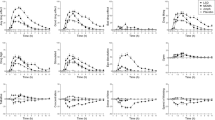Abstract
In a double-blind rossover study, single doses of d-amphetamine and placebo were administered to 12 patients with severe chronic obsessive-compulsive disorder (OCD). Improvement of obsessional symptoms was significant on clinical ratings and was correlated with improved performance on an attention task. Changes were also significant for self-rated measures of activation and altered reality. The behavioral response to amphetamine was not statistically correlated with subsequent improvement during a 6-week clomipramine trial, although the direction of change was the same during both treatments for every patient studied.
Similar content being viewed by others
References
Altschuler M (1962) Massive doses of trifluoperazine in the treatment of compulsive rituals. Am J Psychiatry 119:367
Ananth J (1976) Treatment of obsessive compulsive neurosis: Pharmacological approach. Psychosomatics 17:180–184
Brown WA, Corriveau DP, Ebert MH (1978) Acute psychologic and neuroendocrine effects of dextroamphetamine and methylphenidate. Psychopharmacology 58:189–195
DelRio J, Fuentes JA (1969) Further studies on the antagonism of stereotyped behavior induced by amphetamine. Eur J Pharmacol 8:73–78
Ebert M, Van Kammen DP, Murphy DL (1976) Plasma levels of amphetamine and behavioral response: In: Gottschalk L (ed) Pharmacokinetics of psychoactive drugs: Blood levels and clinical response. Spectrum, New York, pp 157–169
Ellinwood EH Jr (1967) Amphetamine psychosis. I. Description of the individuals and process. J Nerv Ment Dis 144:273–283
Frye PE, Arnold LE (1981) Persistent amphetamine-induced compulsive rituals: Response to pyridoxine (B6). Biol Psychiatry 16:583–587
Fawcett J, Siomopoulos V (1971) Dextroamphetamine response as a possible predictor of improvement with tricyclic therapy in depression. Arch Gen Psychiatry 25:247–255
Hussain MZ, Assad I (1970) A treatment of obsessive-compulsive neurosis (letter). Can Med Assoc J 103:648–650
Insel TR (1982) Obsessive compulsive disorder: Five clinical questions and a suggested approach. Comp Psychiatry 23:241–251
Insel TR, Murphy DL (1981) The psychopharmacologic treatment of obsessive compulsive disorder: A review. J Clin Psychopharmacol 1:304–311
Insel TR, Alterman I, Murphy DL (1982) Antidepressant and antiobsessional effects with clomipramine. Psychopharmacol Bull 18: 315–319
Insel TR, Murphy DL, Cohen RM, Alterman I, Linnoila M, Kilts C (1983) Obsessive-compulsive disorder: A double-blind treatment study of clomipramine and clorgyline. Arch Gen Psychiatry (in press)
Jelliffe SE (1927) Postencephalitic respiratory disorders. Nervous and Mental Disease Publications, New York
Marks IM, Stern R, Mawson D, Cobb J, McDonald R (1980) Clomipramine and exposure for obsessive-compulsive rituals. Br J Psychiatry 36:1–25
Meldman MJ (1970) Diseases of attention and perception. Pergamon, New York
Murphy DL, Pickar D, Alterman IS (1982) Methods for the quantitative assessment of depressive and manic behavior. In: Burdock EI, Sudilovsky A, Gershon S (eds) The behavior of psychiatric patients. Marcel Dekker, New York, pp 355–392
Nurnberger JI, Gershon ES, Simmons S, Ebert M, Kessler LR, Dibble E, Jimerson SS, Brown GM, Gold P, Jimerson DC, Guroff JJ, Storch FI (1982) Behavioral, biochemical, and neuroendocrine responses to amphetamine in normal twins and ‘well-state’ bipolar patients. Psychoneuroendocrinology 7:163–176
Post RM, Gerner RH, Carman JS, Gillin JC, Jimerson DC, Goodwin Fk, Bunney WE Jr (1978) Effects of a dopamine agonist piribedil in depressed patients. Arch Gen Psychiatry 35:609–615
Randrup A, Munkvad I (1967) Stereotyped activities produced by amphetamine in several animal species and man. Psychopharmacologia 11:300–310
Randrup A, Braestrup C (1977) Uptake inhibition of biogenic amines by newer antidepressant drugs: Relevance to the dopamine hypothesis of depression. Psychopharmacology 53:309–314
Rapoport J, Elkins R, Mikkelsen E, Lipsky A (1980) Clinical controlled trial of chlorimipramine in adolescents with obsessive-compulsive disorder. Psychopharmacol Bull 16:61–63
Ridley RM, Baker HF, Haystead TAJ (1981) Perseverative behavior after amphetamine: Dissociation of response tendency from reward association. Psychopharmacology 75:283–286
Rosvold HE, Mirsky AF, Sarason I, Brunsome E, Beck L (1956) A continuous performance test of brain damage. J Consult Psychol 20:343–350
Schilder P (1938) The organic background of obsessions and compulsions. Am J Psychiatry 94:1397–1430
Schiörring E (1975) Changes in individual and social behavior induced by amphetamine and related compounds in monkeys and man. In: Ellinwood EH, Kilbey MM (eds) Cocaine and other stimulants. Plenum, New York, pp 481–516
Silberman EK, Reus VI, Jimerson DC, Lynott AM, Post R (1981) Heterogeneity of amphetamine response in depressed patients. Am J Psychiatry 138:1302–1307
Tecce JJ, Cole JO (1974) Amphetamine effects in man: Paradoxical drowsiness and lowered electrical brain activity (CNV). Science 185:451–455
Thoren P, Åsberg M, Cronholm B, Jörnestedt L, Träskman L (1980) Clomipramine treatment of obsessive compulsive disorder: A controlled clinical trial. Arch Gen Psychiatry 37:1281–1289
Van Kammen DP, Murphy DL (1978) Prediction of imipramine antidepressant response by a 1-day d-amphetamine trial. Am J Psychiatry 135:1179–1183
Van Kammen DP, Murphy DL (1979) Prediction of antidepressant response to lithium carbonate by a 1-day administration of d-amphetamine in unipolar depressed women. Neuropsychobiology 5:266–273
Van Kammen DP, Murphy DL (1975) Attenuation of the euphoriant and activating effects of d- and l-amphetamine by lithium carbonate treatment. Psychopharmacologia 44:215–224
Van Kammen DP, Bunney WE Jr, Docherty JP, Murder SR, Ebert MH, Rosenblatt JE, Rayner JN (1982) d-Amphetamine induces heterogeneous changes in psychotic behavior. Am J Psychiatry 139:991–997
Wallach MB (1974) Drug-induced stereotyped behavior. In: Usdin E (ed) Neuropsychopharmacology of monoamines and their regulatory enzymes. Raven, New York, pp 241–260
Wallach MB, Gershon S (1972) The induction and antagonism of central nervous system stimulant induced stereotyped behavior in the cat. Eur J Pharmacol 18:22–26
Author information
Authors and Affiliations
Rights and permissions
About this article
Cite this article
Insel, T.R., Hamilton, J.A., Guttmacher, L.B. et al. D-Amphetamine in obsessive-compulsive disorder. Psychopharmacology 80, 231–235 (1983). https://doi.org/10.1007/BF00436159
Received:
Issue Date:
DOI: https://doi.org/10.1007/BF00436159




